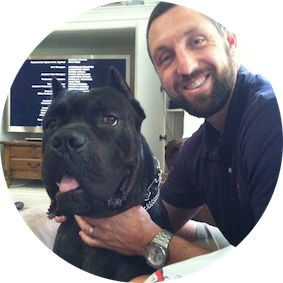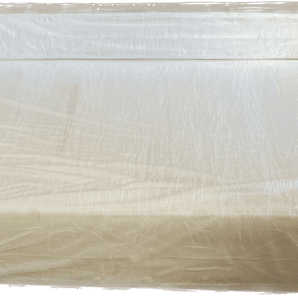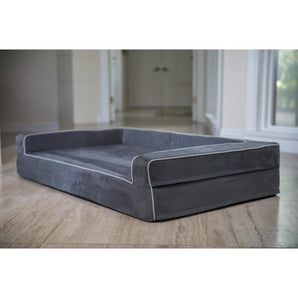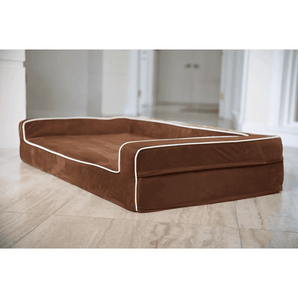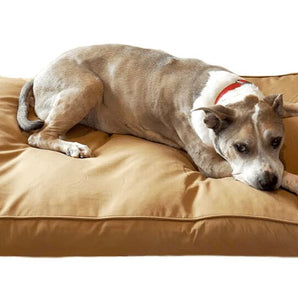You just brought home your new puppy...congratulations! But...now what do you do with the rambunctious little fur ball? Among all the snuggles, playtime, and potty training, there’s one important thing to check off your list—getting your furry friend comfortable with wearing a collar. Since puppies grow rapidly, it's essential to choose the right collar and ease your pup into wearing it comfortably. The training process should be fun, positive, and stress-free so that your puppy associates their collar with good things (like treats and belly rubs).
Choosing The Best Collar For Your Puppy
Before diving into training, it's important to find a collar that suits your puppy’s needs. Not all collars are created equal, and the right choice will make all the difference in your puppy’s comfort and adaptability. Start by selecting a lightweight, adjustable collar made from soft but durable materials like nylon or padded leather. These materials are gentle on your dog's neck and won’t feel too heavy, especially for smaller breeds. The collar should have a secure but easy-to-use buckle or snap closure to ensure it stays in place without causing discomfort. Next, measure your puppy’s neck using a flexible measuring tape and ensure that you can fit two fingers snugly between the collar and the dog's neck. This allows for a proper fit that isn’t too tight or too loose. Since puppies grow rapidly, check the fit often and adjust as needed to accommodate their growth. Finally, consider a collar with an ID tag attachment in case your puppy ever wanders off. Reflective stitching or bright colors can also be helpful for visibility during outdoor adventures.
How To Train Your Puppy to Wear a Collar

Now that you’ve picked the perfect collar for your puppy, it’s time to introduce it in a way that feels natural and stress-free. For many puppies, wearing a collar is a brand-new experience, and like anything new, it may take a little patience and positive reinforcement. The key is to make the training process enjoyable while gradually helping your pup adjust. Here are eight simple steps to ensure your furry friend gets used to their new collar with minimal fuss and maximum tail wags!
1. Introducing The Collar to Your Puppy
The first step in the training process is introducing the collar in a way that feels safe and exciting for your puppy. Before putting it on, allow your pup to sniff, touch, and explore the collar. Place it near their food bowl or favorite toys to create a positive association. If they seem hesitant, try rubbing the collar with your hands or a blanket they like so it carries a familiar scent. Keeping the introduction casual and rewarding curiosity with treats will help ease any initial apprehension. If your puppy shows curiosity, reward them with praise or a small treat. Let them engage with the collar at their own pace, sniffing and even playing with it. This builds their confidence and helps them see the collar as a normal part of their environment. Avoid forcing the collar on too quickly—this should be a gradual process to help your pup feel at ease.
2. Finding The Right Fit Around Your Puppy's Neck
Once your pup is comfortable with the collar, it’s time to secure it around their neck. Gently place it on and fasten it according to the two-finger rule, ensuring a proper fit. If your puppy seems bothered, reassure them with soft pets and gentle words. Some puppies may freeze or scratch at the collar initially, which is completely normal. Encourage them with praise, a tasty treat, or a fun distraction so they associate the collar with positive experiences. At first, they may paw at it or try to shake it off, which is completely normal. Redirect their attention with a fun game or treat to help them adjust.
3. Getting Used to The Puppy Collar
Start by having your puppy wear the collar for short periods, gradually increasing the duration as they adjust. Supervise them closely to ensure they’re comfortable and not trying to remove it. If they scratch at it, don’t immediately take it off—this might reinforce the behavior. Instead, distract them with playtime or a favorite chew toy. Many puppies will stop noticing the collar after a few minutes, so patience and consistency are key during this phase. To further ease the transition, incorporate collar time into daily routines. Have your puppy wear the collar while engaging in activities they enjoy, such as eating, playing, or cuddling. This helps them associate it with positive experiences rather than discomfort.
4. Fun Activities For Distraction
Distraction can be a great tool for helping your puppy forget they’re wearing a collar. Engage them in fun activities like fetch, tug-of-war, or short training sessions with commands like “sit” or “stay.” The more they associate wearing the collar with good things, the easier the transition will be. For smaller breeds that may be more sensitive to new experiences, try keeping play sessions short and full of encouragement. Adding a fun treat puzzle can also keep their mind occupied and off the new sensation around their neck.
5. Rewarding Positive Behavior
Positive reinforcement is a powerful training tool! Reward your puppy with treats, praise, or belly rubs whenever they wear the collar without fussing. If they ignore it completely, that’s even better—reward them for that too. Avoid reacting to any initial discomfort. Instead, wait for moments when they’re calm and happy before offering rewards. Over time, this will help your pup associate their collar with positive experiences and reduce any resistance.
6. Monitoring for Discomfort or Irritation
Check your puppy’s collar regularly to ensure it isn’t causing irritation or discomfort. Look for any signs of chafing, redness, or hair loss around their neck. If you notice any issues, try adjusting the fit or switching to a softer material. Puppies grow quickly, so be sure to loosen or replace their collar as needed. If your puppy seems excessively bothered by their collar—scratching at it, whining, or trying to remove it—it’s worth taking a step back and reassessing their comfort level. Some puppies may have sensitivities to certain materials, so opting for a lightweight, padded, or breakaway collar can help. Additionally, checking for trapped fur or debris under the collar can prevent irritation. Make it a habit to remove the collar occasionally, especially during supervised playtime or naps, to give your pup’s neck a break and ensure they stay happy and comfortable.
7. Preparing For Leash Training
Once your puppy is comfortable wearing a collar, the next step is leash training! Before attaching a leash, encourage your pup to walk calmly around the house while wearing their collar. Reward them for good behavior and gradually introduce the leash in a positive way, just like you did with the collar. Let them drag the leash around under supervision to get used to the weight, then practice gentle guidance using treats and encouragement. Keeping this process gradual and positive will make the leash feel like an exciting new tool rather than a restriction.
8. Keeping The Dog Collar Experience Positive
The goal is to make the collar experience a happy and stress-free part of your puppy’s routine. Keep the process positive, be patient, and never force the collar on if they’re showing signs of extreme distress. If your puppy is feeling anxious about wearing a collar, calming chews can be a helpful tool to ease their stress. These chews are often made with natural ingredients like chamomile, melatonin, or L-theanine, which promote relaxation without making your pup drowsy. Offering a calming chew about 30 minutes before introducing or adjusting the collar can help take the edge off and make the experience more positive. Just be sure to choose a high-quality, vet-approved option like the Bully Beds K9 Calm Anxiety Chews for Dogs, and monitor your puppy’s reaction to ensure it works well for them. Pairing calming chews with plenty of praise, treats, and fun distractions can turn collar training into a smooth and stress-free process!
Getting a Collar on a Puppy: Your First Big Milestone!

Training your puppy to wear a collar might seem like a small thing, but it’s actually a huge step in their journey. Every successful moment—from their first sniff to forgetting it’s even there—builds their confidence and strengthens your bond. Keep the training process light, fun, and full of rewards, and before you know it, your pup will be ready for even bigger adventures (like leash training, and yes, maybe even mastering the art of not eating everything in sight).

